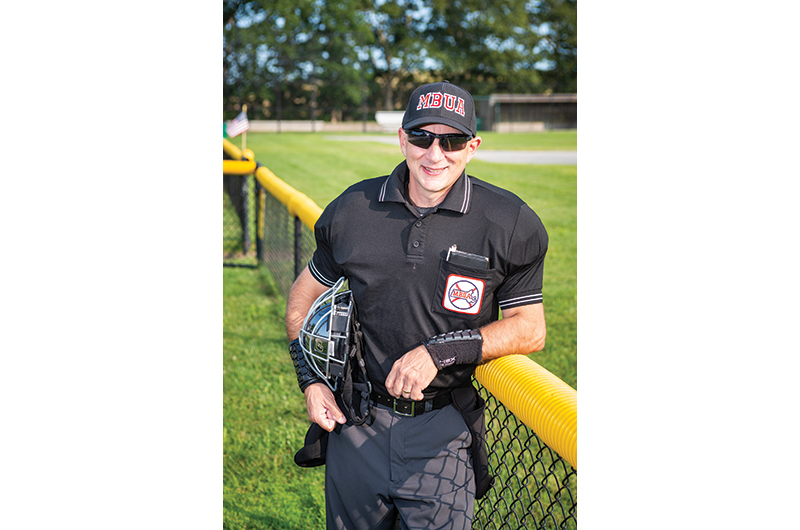‘Tis the World Series season, a time baseball fans and commentators cheer players present and past and jeer umpires. All of which reminds me of signs that have gone up at Viera Park in Oak Bluffs, where Martha’s Vineyard Little Leaguers play baseball. In bold letters, the signs shout: “Please Remember: 1. These are kids; 2. This is a game; 3. The coaches are volunteers; 4. The umpires are human; 5. This is NOT the World Series.”
Rick Mello, Little League president and umpire-in-chief, says he encouraged posting the signs. “It’s tough,” he says, as an umpire. “People test out the boundaries – what they can get away with.” But he credits Island players, parents, and coaches with being “for the most part, well-behaved.” Mello, who also umpires Babe Ruth, junior varsity and varsity high school baseball, women’s slow pitch, and fills in for other games, says he has never ejected anyone. “I strive to be unflappable,” he says, but he admits to times when “the chirping gets under my skin.” He has resorted to a handful of formal warnings to players who lost control and engaged in unsportsmanlike behavior, and to coaches “who wouldn’t stop arguing with me” or were “on my case every single pitch.” Ninety percent of the time, however, he says umpiring “is just a blast.”
A fifth-generation Vineyarder, Mello, forty-nine, got into coaching and umpiring when his children, Michael, now a high school senior, and Emily, a senior at University of Massachusetts – Boston, became interested in organized baseball. As an umpire, he represents several Island traditions. First, he is part of a full-circle mentoring chain that goes back generations. He credits Larry Johnson, the Island’s only other Little League umpire certified by the state’s umpire association, with mentoring him. And Johnson, who began umpiring thirteen years ago, cites umpire Ray Tattersall as a key mentor for him. Tattersall, who umpired from 1995 to 2015, recalls the legendary Richard C. Brown as a model for him of umpiring fairness. Brown, who moved to the Vineyard from Staten Island in 1967 and started the Dairy Queen in Edgartown, umpired Little League on the two islands for a total of fifty-three years. John Cramer, a Vineyard Little Leaguer, recalled, “My hero, Mr. Brown, taught young kids how to lose with dignity and how to win with honor, and those are lessons I will never forget.” One of the Little Leaguers Brown taught in the 1980s is Mello.
Second, Mello, outfitted in almost $1,000 of professional umpire gear – a new navy-blue chest protector, mask, shin guards, cap, pants, shirt, and equipment bag – makes the game feel more professional by his appearance. Generations of the public and the press have taken notice of umpires’ appearance, as evidenced by the baseball coverage in the July 17, 1934, Vineyard Gazette: “Umpire John Andrews turned out for the first time in his official umpire’s uniform, protector and mask.”
But Mello’s new gear – for example, the $250 spring mask – also has a practical purpose. When a ball hits the mask, says Mello, “I don’t feel it.” But Johnson, seventy-one, who uses an old mask without springs, says a foul ball or errant pitch can knock the mask off his face: “It’s like getting punched.”
Third, Mello and other umpires see themselves as teachers. When members of the hitting team make fun of a pitcher or mock a fielder for dropping a fly ball, he reminds the team of proper sportsmanship. When a batter stands too close to the plate or a catcher squats too close, Mello tells the player where to move. And he doesn’t take offense when a catcher or batter asks whether a pitch was a strike or ball. “I don’t take that as criticism,” he says. He feels conversation with players is part of his role as teacher, a role he comes by naturally. Mello is also the high school’s “one-man-show” information technology director, working with virtually every department to help them use the available technologies effectively.
Fourth, Mello acknowledges that he occasionally misses calls but always shoots for consistency and fairness, a goal of generations of Vineyard umpires. He describes the difficulty of calling strikes with Little Leaguers throwing arcing pitches to batters, some of whom are only about four feet tall. The Little League strike zone, from the armpits to the bottom of the knees, is hard for pitchers to hit. Pitchers throw many balls. Mello says, “You don’t want the game to devolve into a walk carousel. But you also want to be fair to the batters.”
I turned to my granddaughter Rose, a nine-year-old, four-foot-two-inch, minor league Little Leaguer for an assessment of Mello’s umpiring skills. She smiled, offering some good-natured quibbling about the size of the batter’s strike zone, but said of Mello: “Good caller.” The Little League needs more such callers willing to memorize an encyclopedic rulebook and regularly endure criticism while, except for umping championship games, receiving no pay. No wonder the first order of business on the Little League website is: “Finding umpires – we have a shortage.” May the league find more umpires like Mello.





